Affiliate disclosure: This post may contain affiliate links. Please see our Privacy Policy.
Bielefelder chickens are a productive dual-purpose breed that’s docile, hardy, and easy to raise. They lay distinctive dark brown to chocolate-colored eggs, and are commonly used in crosses to create “olive egger” chickens that lay rare green eggs. They’re the perfect addition to any backyard flock, and the most challenging thing is simply learning to pronounce their name!
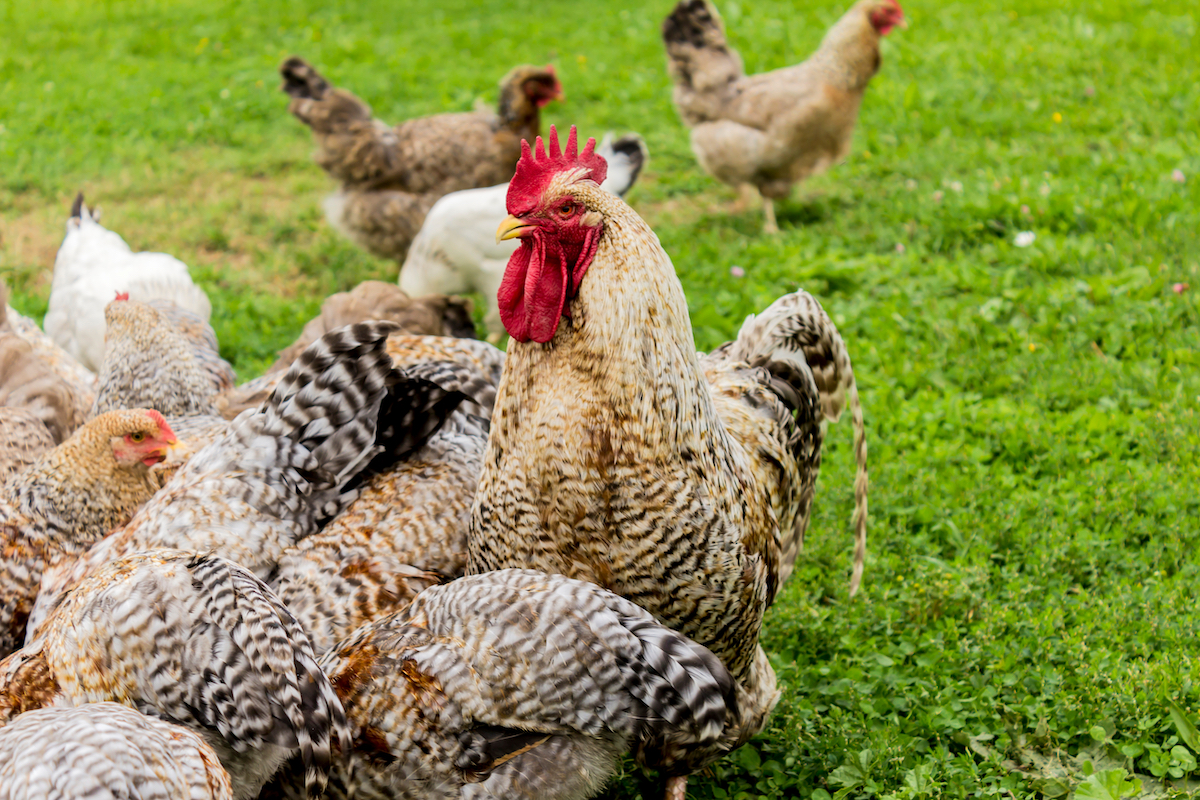
Table of Contents
- What are Bielefelder Chickens?
- Bielefelder Chicken Characteristics
- Bielefelder Breed Standard
- Temperament
- Hardiness
- Egg Production
- Egg Color
- Meat
- Broodiness
- Foraging Ability
- Cross Breeds
- Common Health Issues
- Pros and Cons of Bielefelder Chickens
- Tips for Raising Bielefelder Chickens
- Bielefelder Chicken FAQ
- Are Bielefelder chickens friendly?
- Are Bielefelder chickens good egg layers?
- What color egg does a Bielefelder lay?
- Are Bielefelder hens broody?
- How big are Bielefelder chickens?
- Are Bielefelder chickens good eating?
- Are Bielefelder chickens autosexing?
- Are Bielefelder chickens cold hardy?
- How long do Bielefelder chickens live?
- Are Bielefelder chickens easy to raise?
- Chicken Breed Guides
- Raising Backyard Chickens
This year we decided to add more egg colors into our basket from our backyard chickens. My daughter absolutely loves chickens that lay colorful, rainbow eggs and I started researching how chicken egg colors are formed.
I quickly learned that there are no single pure breeds of chicken that lay green eggs, and to get “olive eggers” as they’re called, you have to breed a dark brown egg laying chicken with a blue egg laying chicken. Blue egg layers are easy enough, as Americana chickens are well known for their bright blue eggs and we had already decided on those.
With a bit of research, I learned that the most popular choice for roosters in “rainbow egg” flocks are Bielefelder roosters. I’d never heard of them, but they’re no only incredibly friendly and personable, but the breed is also known for their distinctive egg color.
In most breed guides, you’ll read that they lay “brown” eggs like many other chickens, but that’s not the whole story. They actually have really unique pigmentation in their egg shells, and it’s a dark brown with a slight pink hue.
When you mix a Bielefelder with a blue egg laying chicken, you get the perfect shade of green egg in the next generation.
Knowing that, I added them to our flock and I’ve been amazed at how gentle and friendly this breed really is. The roosters are my daughter’s favorite, and they actually rub against her leg like cats for snuggles. I’ve never met a kinder chicken, and yet, they still watch over the ladies with diligence.
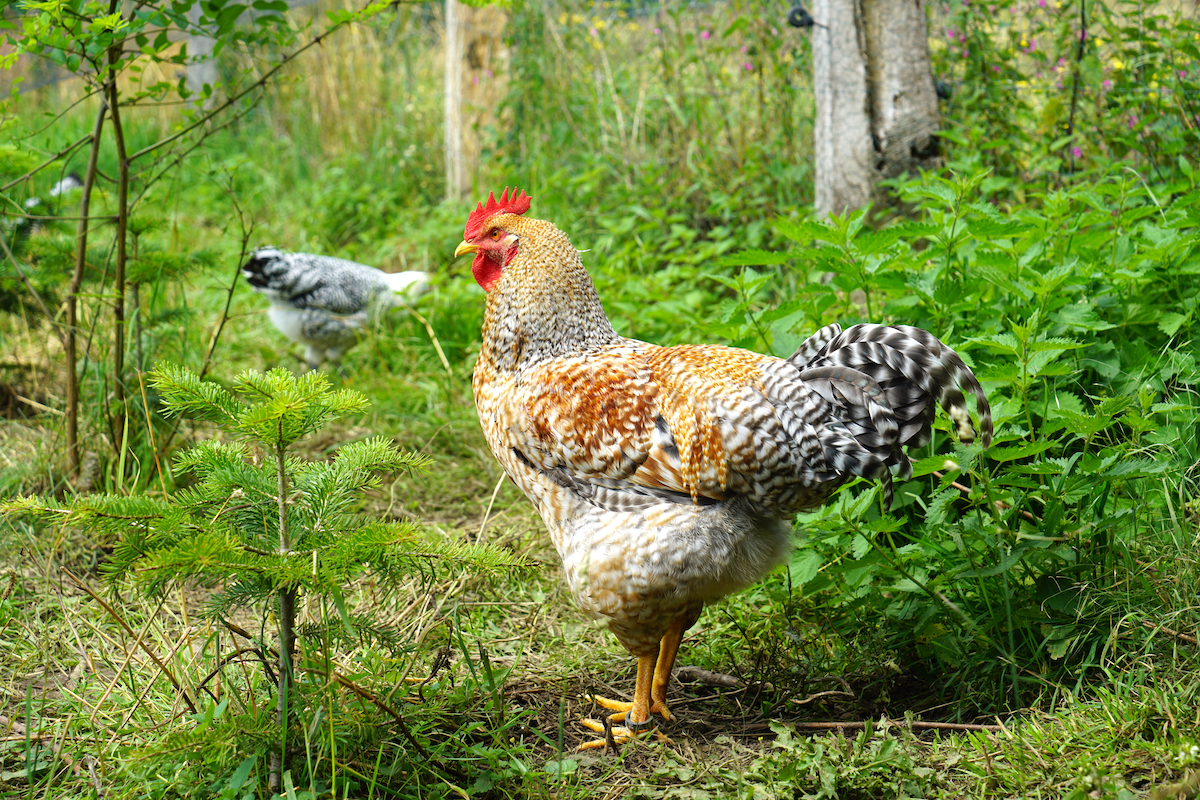
What are Bielefelder Chickens?
The Bielefelder breed has been around since the 1970s. It was then that German chicken breeder, Gerd Roth, created them by combining breeds such as the New Hampshire, Wyandotte, Cuckoo Malines, and Amrock. The Bielefelder arrived in the United States in 2011 and has since gained great popularity.
These birds offer magnificent color with red combs, earlobes, and wattles. Their feather coloring includes orange, gray, black, white, and brown, with pink tinges, which help them blend into their surroundings as a kind of camouflage. And coloring plays a significant role, even in chicks.
They are auto-sexing, which means you can tell the males and females apart as soon as they hatch. Then, as they mature, their complex, spotted patterns emerge, helping them blend into the landscape to avoid predators.

Bielefelder Chicken Characteristics
Known as gentle giants with a docile disposition, Bielefelders often seek human companionship and are easy to raise. You’ll find that the roosters are willing to cuddle with their humans but will fight off predators to keep their ladies safe just as quickly.
They’re plump and round, revered as dual-purpose birds, which means you can raise them for both eggs and meat. Males and females weigh about the same, at about ten to twelve pounds after 22 weeks. They tolerate heat and cold well and aren’t likely to slow egg production when the temperatures drop.
- Breed Name: Bielefelder Kennhuhn (pronounced BEE-LAY-FELDER)
- Breed Type: Standard for eggs, meat, and ornamental purposes
- Temperament: Gentle and docile, though roosters are very protective of the flock
- Size: Jumbo. Females average 9 ½ pounds, and males average 12 pounds
- Eggs Per Year: 220 to 280+
- Egg Size: Large
- Egg Color: Brown/Chocolate
- Lifespan: 7 to 10 years
- Time To Maturity: 22 weeks
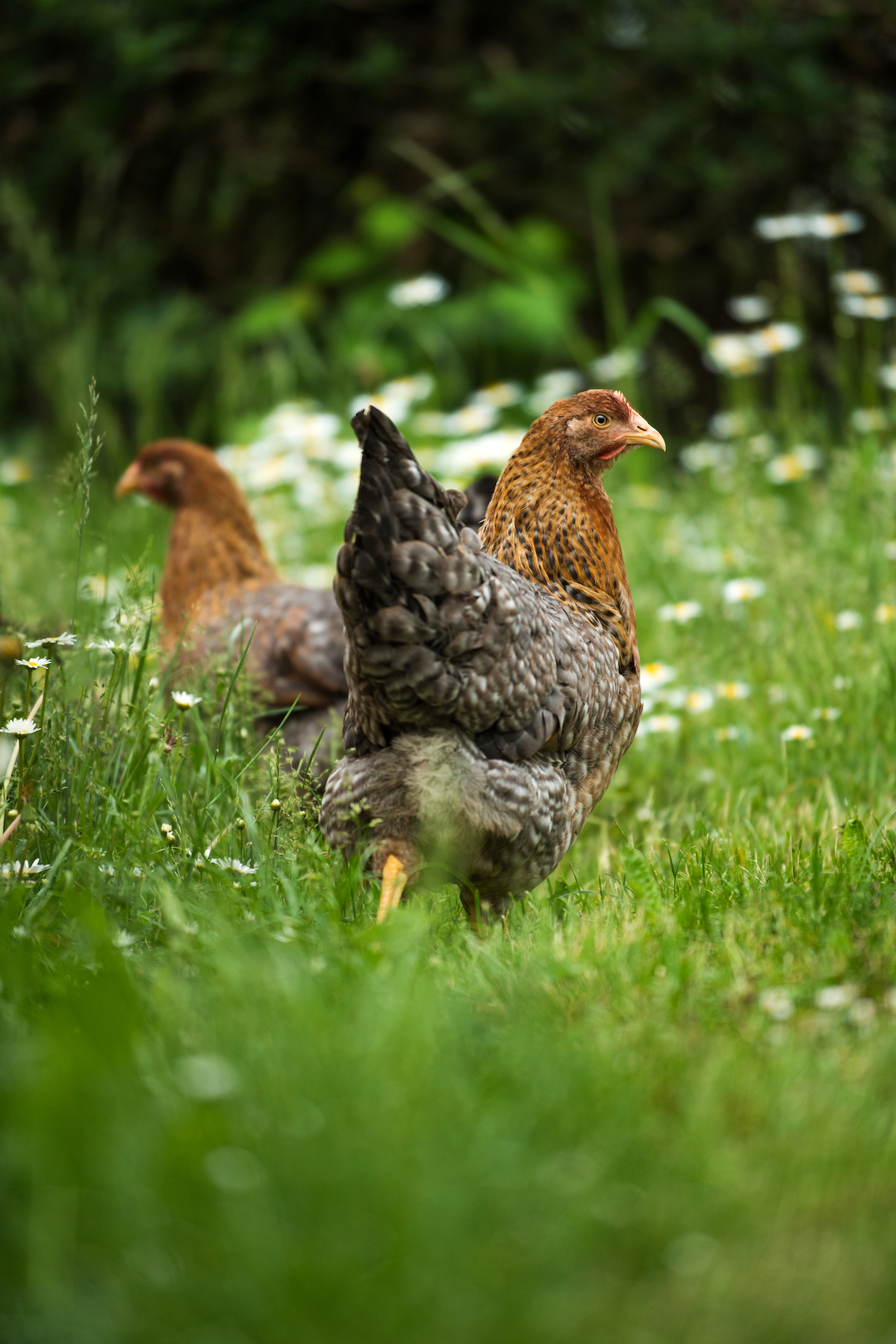
Bielefelder Breed Standard
You’ll be able to tell the male Bielefelder chicks from the females right after hatching. At just a day old, the pullets will have a dark “chipmunk” stripe down their backs, while the males are lighter and show a white speck on top of the head.
Once mature, females have a brown feather color with white and gray bars as an overlay, but males are more orange, with black tails and breasts that are barred. Since this is a heritage breed, these colors will continue to breed true.
As you research the coloring, you’ll hear about the cuckoo pattern, featuring black breasts with red color, and the Silver, which is missing the red and yellow feather variations seen in some birds. Their legs are yellow, without features, and they have a single comb.

Temperament
If you’re looking for a chicken that doubles as a pet, Bielefelders are an excellent choice. They are quiet, curious, and tend to prefer human companionship, with a friendly, docile demeanor. If you have young children, this is the perfect choice for a front yard free ranger. Roosters follow this standard temperament, especially if you treat them well and socialize with them often.
Roosters are often seen calling their girls to food during foraging, but the presence of a predator can bring out protective aggression that keeps the flock safe. If you find your Bielefelder roo is more aggressive than it should be, even after taking all the precautions, consider removing him from the flock in favor of a more personable fellow.
Hardiness
No matter which geographic location you live in, Bielefelders are a hardy choice. From the harshest winter to the driest summer, these birds handle both well. When it comes to extremes, however, they will take the brutal cold better than sweltering heat.
However, they still require a coop and environment that keeps them safe and comfortable.
Egg Production
Bielefelder hens lay an average of about 230 large to extra-large eggs each year, with reported numbers going as high as 280 eggs or more per year.
Unlike some other breeds, Bielefelders continue to lay year-round, including colder, darker winter months, when most stop laying. To ensure the best egg production, offer high-quality feed that meets all their nutritional needs.
It’s also important to note that they take a little longer to start producing because of their size and classification as dual-purpose birds.
Egg Color
Bielefelders are brown egg laying chickens, but when listed on a chart without personal knowledge of the breed, it’s easy to overlook the intricacies. The Bielefelder’s brown eggs are distinct to the breed. You’ll find they have a beautiful brown-to-chocolate color with pink undertones.
Their particular egg color is one of the reasons they’re commonly cross bred with with blue egg laying chickens to make dramatic green egg laying “olive egger” chickens.
Meat
As a dual-purpose breed, they’re just as popular for their meat as their eggs. The meat is juicy and delicious, and you get more of it per chicken than other breeds, making it a worthy investment.
Broodiness
Most Bielefelder owners report little to no broodiness in this breed, even with a whole clutch of eggs. But it’s also noted that these hens are fantastic mothers once chicks hatch.
Foraging Ability
Bielefelders are fantastic foragers, with quick reflexes to keep their area insect-free. At the same time, they remain on high alert during their foraging, with a keen eye for incoming intruders.
Cross Breeds
To create the Bielefelder, Gerd Roth crossed Malines, New Hampshire Reds, and Amrock, although there has been some debate about the specific breeds used. You may also hear about two different crosses known as Crele and Silver. Silvers are rare because they were bred out early in the process. However, some heritage farms are bringing them back.
Bielefelder roosters are commonly crossbred with blue egg laying Ameraucana hens to create green egg laying “olive egger” chickens in the next generation. There are not true green egg laying breeds, and in order to have green eggs in your basket, you must cross breed a dark brown egg laying chicken with a blue egg laying chicken.
Common Health Issues
There are no known health issues that are specific to this chicken breed. However, proper care, nutrition, and the environment help ensure they live up to this potential.
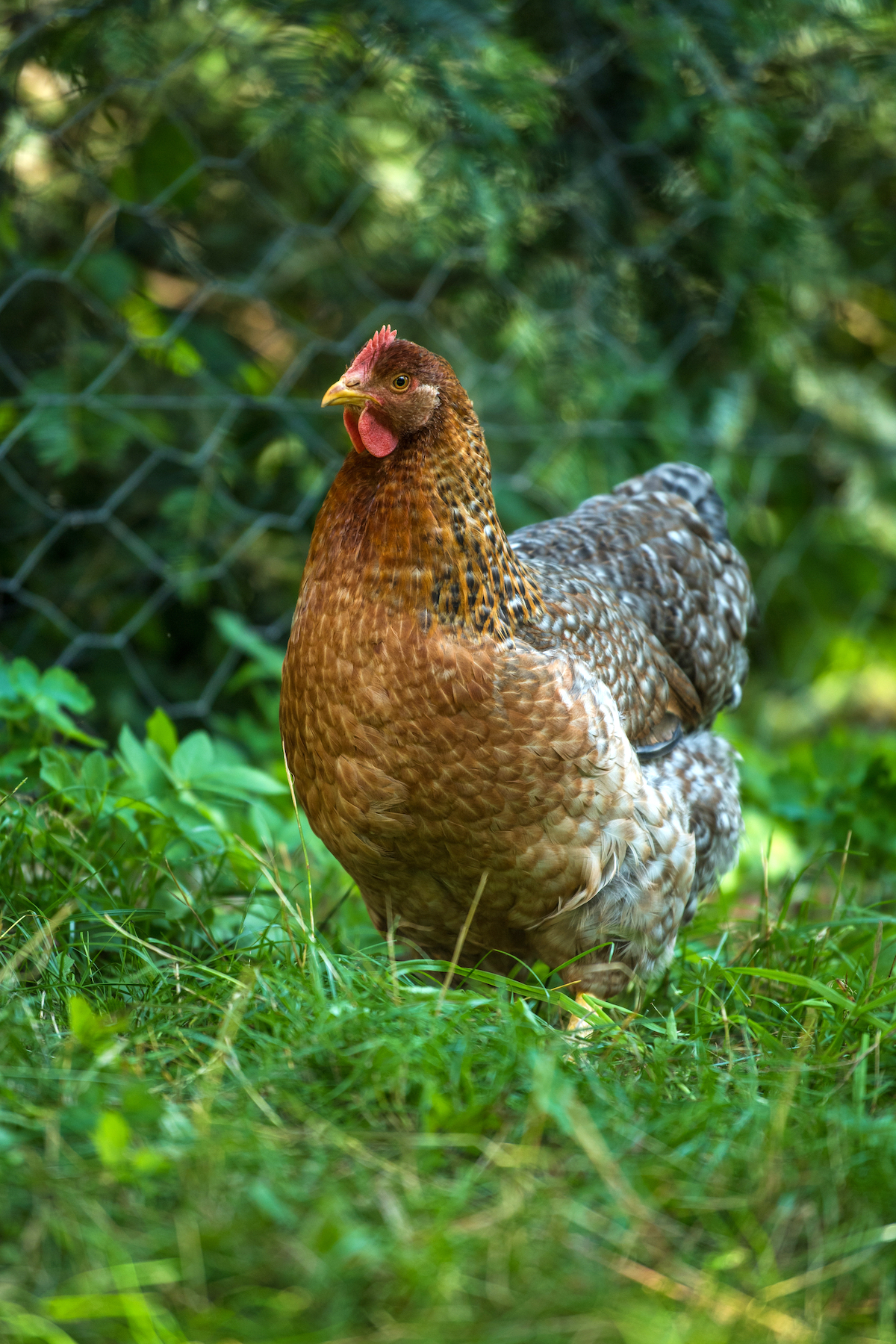
Pros and Cons of Bielefelder Chickens
In my mind, the pros outweigh the cons, but I’ll let you decide.
Pros
- Friendly and docile
- Perfect for families with small children
- Excellent egg production
- Winter egg layers
- Autosexing
- Cold hardy
- Flavorful, nutritious meat
Cons
- Relatively Expensive Chicks, since few hatcheries have them
- Slow weight gain for meat use
- Eats a lot of food if foraging isn’t an option
- Late to start laying eggs, since they’re large dual purpose birds
Tips for Raising Bielefelder Chickens
All chicken breeds require proper nourishment and living conditions, so this is a great place to start. But because Bielefelders can reach weights of up to 13 pounds or more, they eat a lot of food. Even as chicks, their feed needs are higher than others, so ensure they get the right amount.
Foraging, with fresh fruit, veggie, and grain scraps from the house, helps offset the cost, but they need about 20% of their daily intake to be quality protein.
These chickens love to forage and wander, so allow them plenty of space to explore. They won’t do as well in small enclosures. Also, be sure to clean coops and nest boxes often. They’re known to sleep in their nest boxes, which can lead to ill health if left dirty.
Bielefelder Chicken FAQ
At this point, I hope I’ve answered all the common questions about raising Bielefelder chickens, but if you’re looking for answers at a glance to the most common questions, I’m happy to help!
Are Bielefelder chickens friendly?
Yes, they are extremely friendly, and you’ll often find them “underfoot.” They are good-natured, docile, and prefer human companionship at every opportunity.
Are Bielefelder chickens good egg layers?
They are exceptional egg layers, even laying in the winter months when many chickens take a production vacation. There are two things to keep in mind.
First, since they are large birds, they are late layers, which means you won’t get the first egg until they are six to ten months old.
And second, without proper nutrition, they may not lay as often, and their eggs might be smaller.
What color egg does a Bielefelder lay?
Brown. However, this breed’s eggs have noticeable characteristics about their eggs, including a specific chocolatey brown color with pink undertones.
Are Bielefelder hens broody?
Not usually. But Bielefelders will take great care of chicks that hatch in their care.
How big are Bielefelder chickens?
Large/Jumbo. Hens range from eight to ten pounds, and roosters have been known to reach 15 pounds.
Are Bielefelder chickens good eating?
Yes, exceptional. The birds offer more meat per bird, with a delicious, juicy taste.
Are Bielefelder chickens autosexing?
Yes. Young females are dark brown with a prominent “chipmunk stripe” down their back. Males are lighter, with a noticeably lighter stripe on their back and a white or yellow patch on their heads.
Are Bielefelder chickens cold hardy?
Yes, very. The Bielefelder handles hot and cold temperatures well but fares better in the harsh cold than in extreme heat.
How long do Bielefelder chickens live?
The average lifespan of this breed ranges from seven to ten years, with some living longer under the right circumstances. If you’re raising them for food, you can harvest them between the ages of 12 to 16 weeks for the best meat texture, which changes the older they get.
Generally, chickens are productive layers to about 2 to 3 years old, and after that point egg laying drops off dramatically. From 3 to 5 years old, they’re still laying some eggs, but not nearly as many as they were at their prime.
Past 5 or so years, you may occasionally get eggs, but your ladies have reached retirement.
Are Bielefelder chickens easy to raise?
Yes. The Bielefelder breed is excellent for free-range and coop conditions, are on alert against predators, and take great care of their chicks. However, raising them properly will require more feed than smaller breeds.
Chicken Breed Guides
Looking for more chicken breed guides?
- Which Chickens Lay White Eggs?
- Which Chickens Lay Green Eggs? (Olive Eggers)
- Which Chickens Lay Pink Eggs?
Raising Backyard Chickens
Learn more about raising your own chickens at home!
- How Much Does it Cost to Raise a Chicken?
- Beginner’s Guide to Chicken Egg Colors
- What’s the Difference Between a Duck Egg and a Chicken Egg?
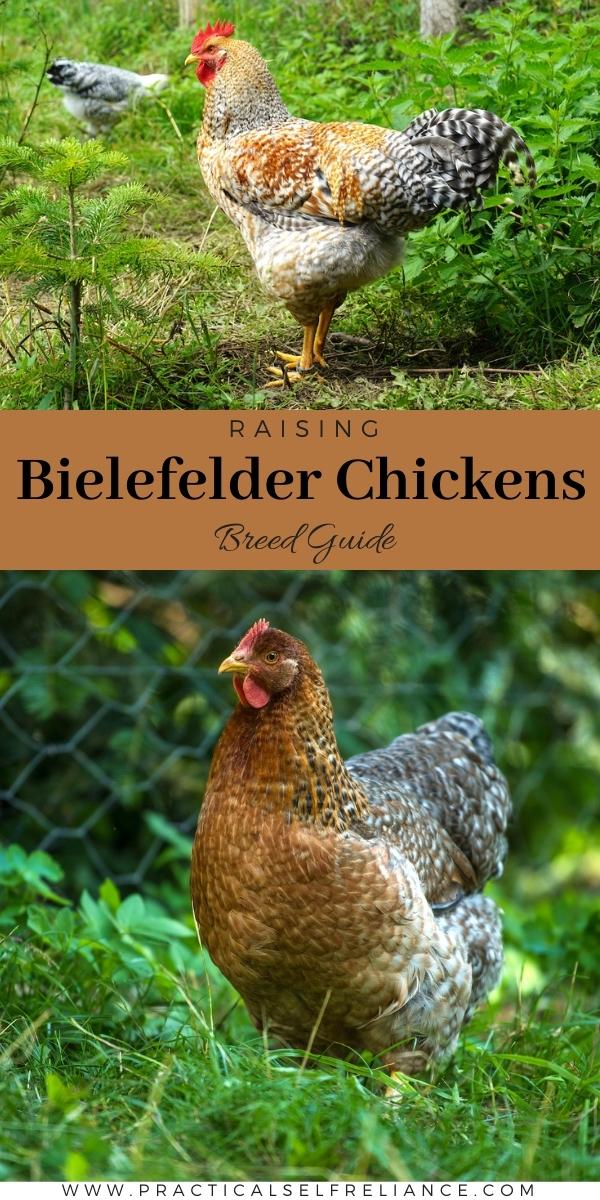

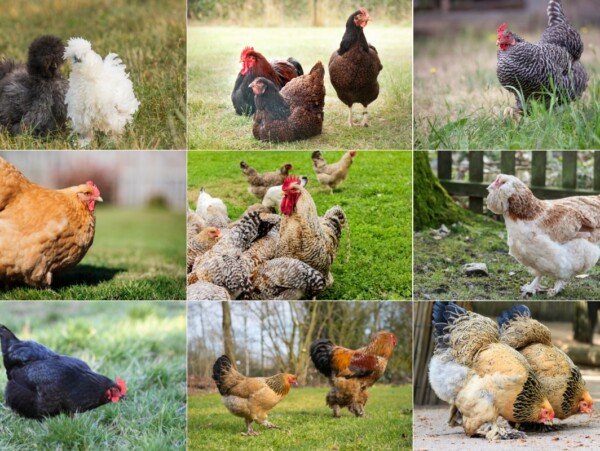
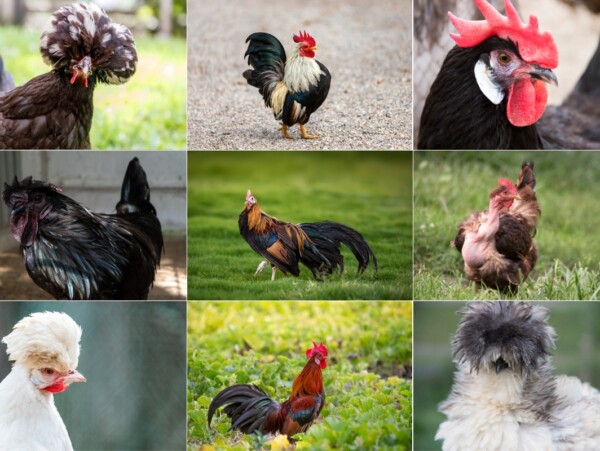
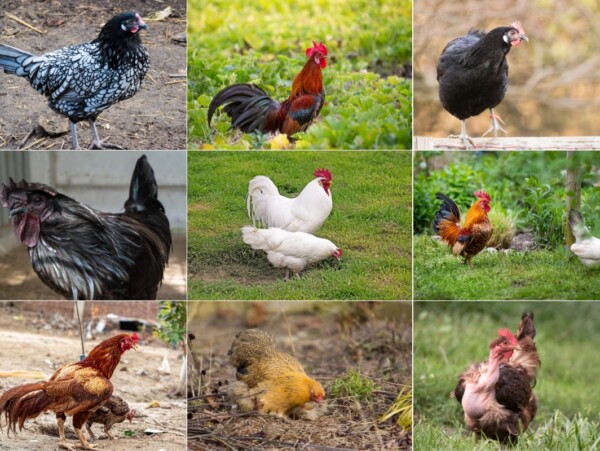










I was wondering, since they are such a large bird, how much roost space on average do they require? Thank you.
You’ll want a minimum of 4 square feet per bird for the coop but if you’ve got more space, that’s even better of course. An average of 8 inches of roost is sufficient.
There is a green egg laying variety. It’s called a Whiting True Green. It’s a relatively new breed. The Murray McMurray hatchery mentioned above carries them. They are excellent layers of large green eggs. We’ve had them for about 5 years now and they lay as well as White Leghorns.
Thank you for sharing. I have heard of those before.
How do I find a hatchery that sells Bielefelder chicks near Ottawa, Kansas?
I don’t know about local hatcheries in Kansas, but this hatchery will ship them (From Iowa): https://www.mcmurrayhatchery.com/bielefelder.html